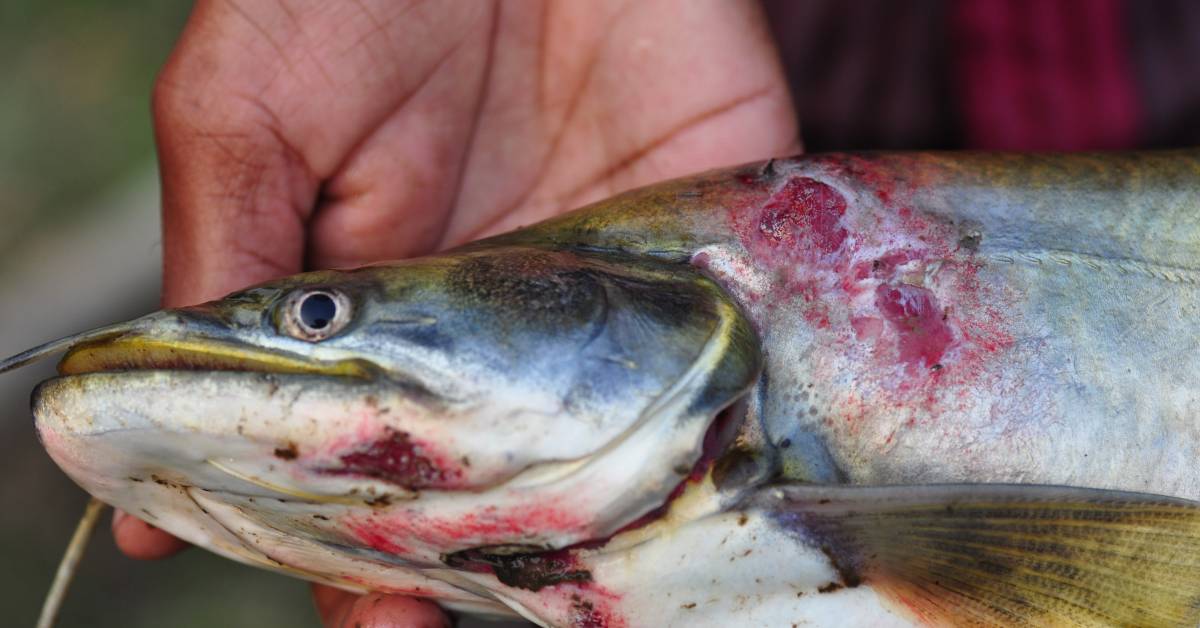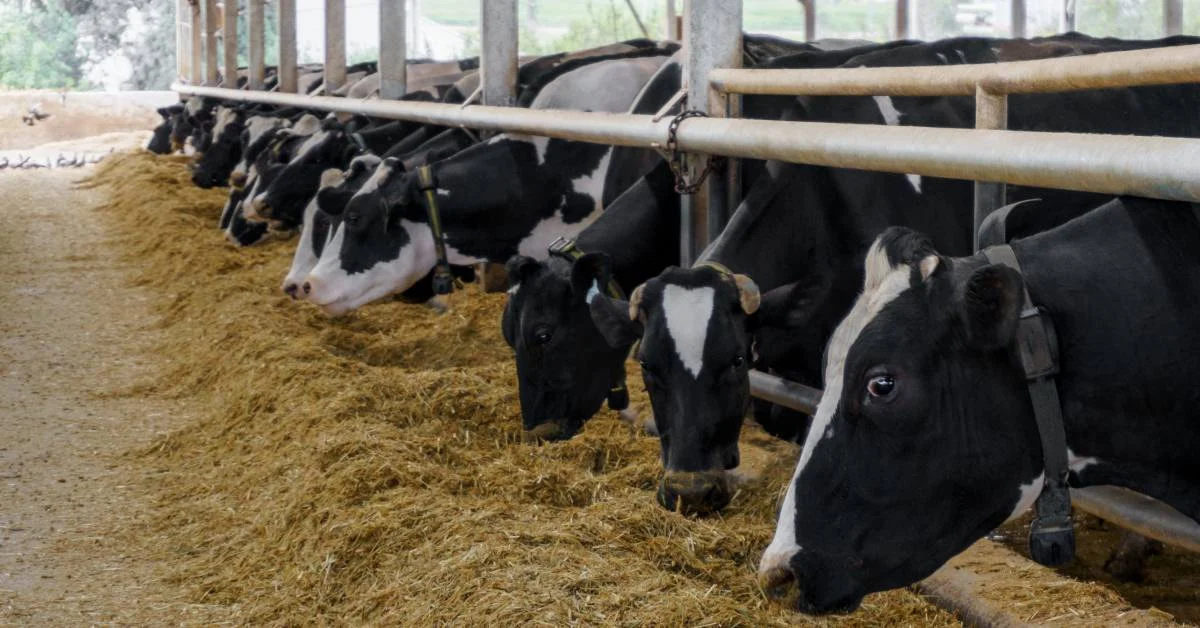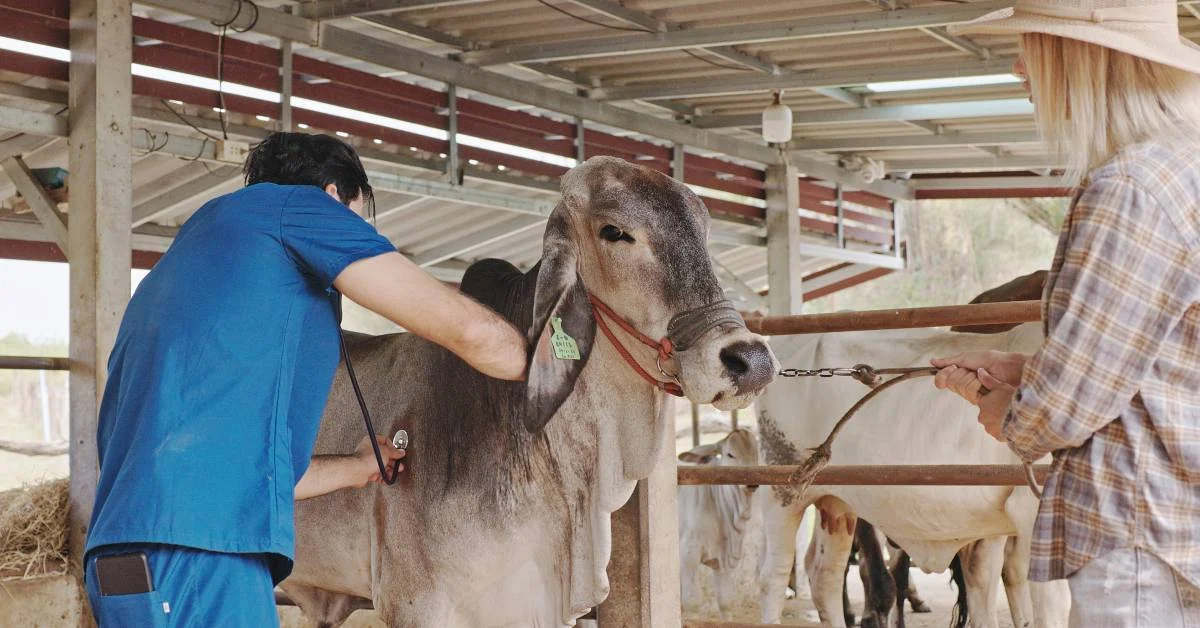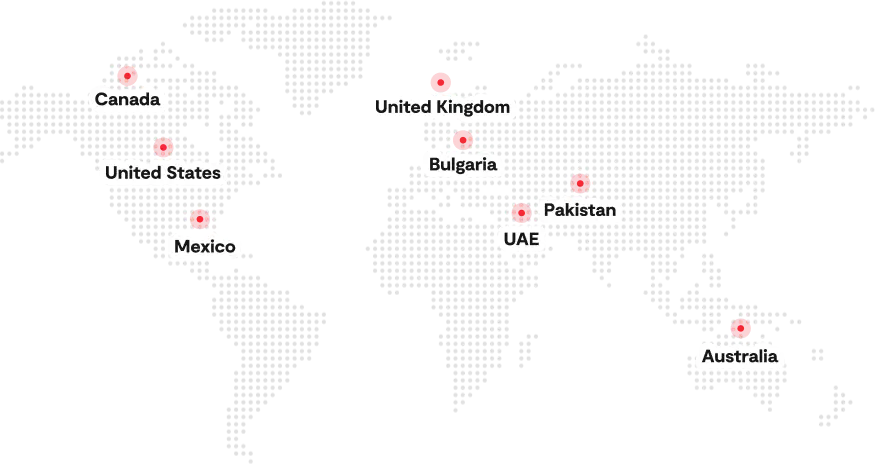Fish farming is one of the fastest-growing food sectors in the world. But just like any other form of livestock farming, fishes are vulnerable to diseases that can wipe out entire stocks and ruin operations. Early diagnosis and fish treatment are critical. A seven year case study from Alabama, USA shows that Commercial catfish farms in Alabama lose about 9 million fish per year (2.9 million kg/year), with bacterial diseases causing over 83% of losses.
Fish diseases are among the leading causes of economic loss in aquaculture, affecting both small-scale farmers and large commercial operations. From stunted growth to sudden die-offs, unchecked diseases can wipe out entire stocks in days. From symptoms to causes to cures, this blog offers actionable knowledge. Whether you’re raising finfish, shellfish, tilapia, salmon, catfish, or ornamental fish, understanding how to spot, prevent, and manage sickness in your stock is non-negotiable.
A Breakdown of the Most Common Fish Diseases
When it comes to sustainable fish farming, knowing the common fish diseases is critical. Fish, like any other livestock, are vulnerable to a range of illnesses caused by bacteria, viruses, fungi, parasites, and even poor water quality. These diseases can spread quickly and wipe out entire stocks if left unchecked.
Most common fish diseases fall into broad categories: bacterial infections, parasitic invasions, fungal outbreaks, and viral illnesses. Each type presents differently, but they often share warning signs like lethargy, unusual swimming behavior, appetite loss, or visible lesions. Identifying which category a disease falls into is the first step toward effective fish treatment.
Whether you’re running a commercial fish farm or managing a small setup, being able to recognize common fish diseases early can make all the difference in maintaining fish health, improving survival rates, and reducing costly losses.
Let’s explore the most common diseases in fishes, their causes, symptoms, and how they can be treated.
Bacterial Infections
Bacterial infections are among the most common fish diseases in aquaculture. They often arise when water quality declines, fish are stressed, or stocking densities are too high. The most prevalent bacterial culprits include Aeromonas, Pseudomonas, and Flavobacterium species.
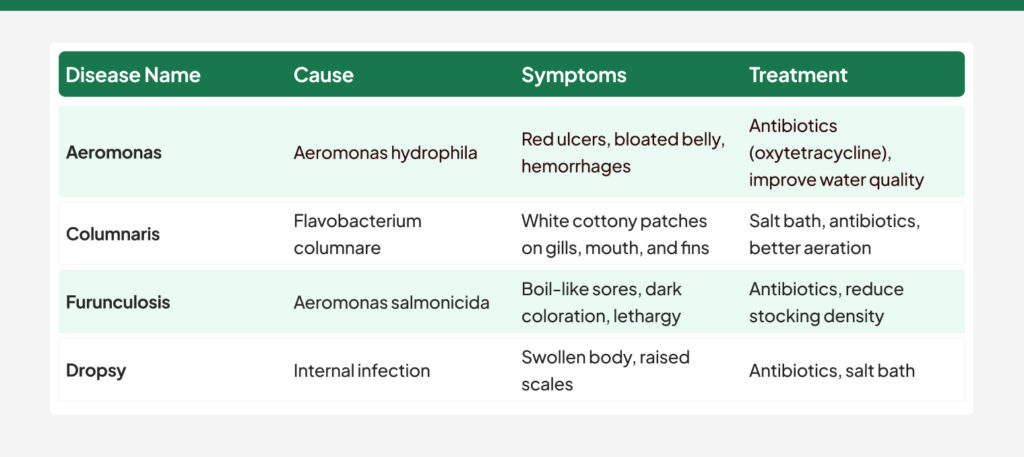
Parasitic Infections
Parasites thrive in poor water conditions and overcrowded systems. They can live on the fish externally or internally, and their impact is often swift and severe. If left unchecked, parasitic infections can lead to secondary diseases, stunted growth, and high mortality rates. Early detection and targeted treatment are key to preventing full-scale outbreaks.
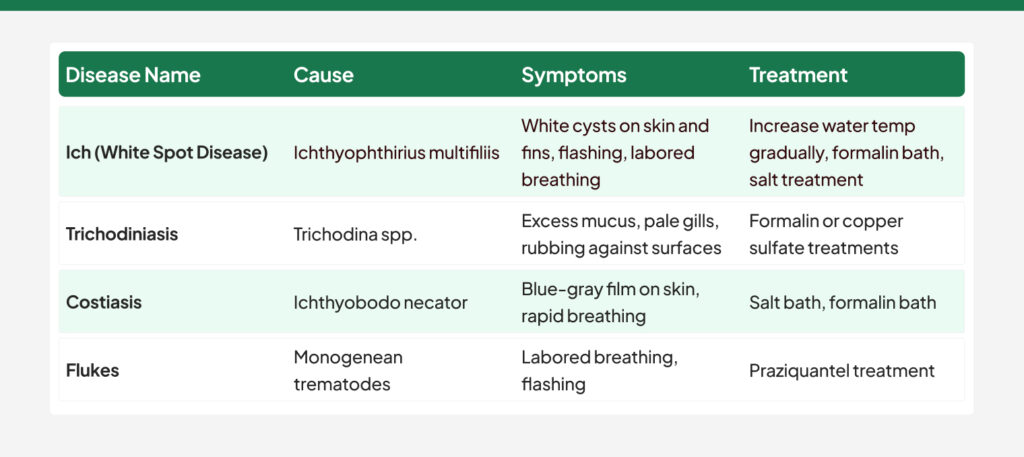
Fungal Infections
Fungal infections in fish often occur secondarily, after stress, wounds, or other diseases compromise the immune system. They’re common in environments with decaying organic matter and stagnant water.

Viral Infections
Viral diseases can be devastating because there’s often no direct fish treatment. Prevention through strengthening the biosecurity of livestock and early detection is key. Vaccines exist for some viral threats, especially in salmon farming.
Note: These viruses spread quickly in high-density systems. Smart farm management can drastically reduce exposure.
Nutritional Diseases
A poor diet can mimic disease symptoms or make fish vulnerable to infections. Nutritional issues are an overlooked part of wasting disease in fish. Deficiencies in essential vitamins, minerals, or amino acids can lead to weakened immunity, poor growth rates, and visible deformities. Addressing these imbalances early with proper feed formulations is crucial for long-term fish health, and as a result, the feed conversion ratios are optimized in parallel.
Did You Know?
Nutritional issues are easier to fix than most diseases, provided you’re using traceable, species-specific aqua feed.
Environmental & Stress-Related Illnesses
Sometimes, fish don’t get sick from a microbe, but from stress. Environmental diseases result from poor water quality, bad handling practices, or temperature swings. Stress weakens the immune system, making fish more susceptible to other common fish diseases. Long-term exposure to suboptimal conditions can lead to behavioral changes, stunted growth, or even mass mortality if not addressed promptly.
Wasting Disease in Fish
Wasting disease in fish refers to a range of conditions where fish lose weight despite eating or show chronic signs of weakness. It’s often caused by underlying parasites or chronic bacterial infections.
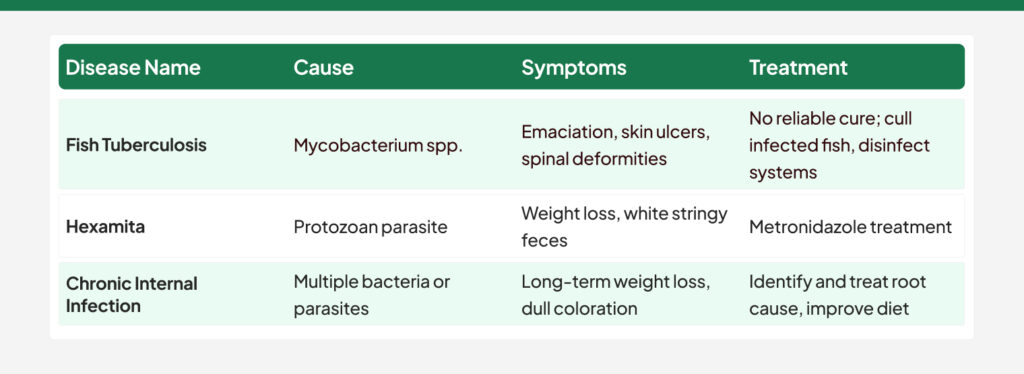
Prevention Tips for Common Fish Diseases
Preventing illness is always more cost-effective and humane than treating it. Whether you’re running a backyard pond or a commercial aquaculture facility, staying ahead of the curve when it comes to common fish diseases can save your stock, your money, and your reputation. Below are key prevention practices that every fish farmer should adopt and why they matter.
Quarantine New Fish for at Least 2 to 4 Weeks
Introducing new fish without proper isolation is one of the fastest ways to spread disease. Even if they appear healthy, new arrivals may be asymptomatic carriers of common fish diseases like Ich or Columnaris. A dedicated quarantine tank allows you to monitor them in a controlled environment and treat any issues before they pose a risk to your main population. Keep the water stable and observe behavior and appetite closely during this period.
Maintain Water Quality by Testing Ammonia, Nitrites, and Oxygen Regularly
Poor water quality is one of the biggest contributors to fish illness. Ammonia and nitrites, both byproducts of fish waste, can quickly become toxic if not addressed. Low oxygen levels also lead to stress and reduced immunity, making fish more susceptible to disease. Regular testing, at least once or twice a week, helps you catch problems early. Tools like digital meters or basic test strips are inexpensive and essential.
Avoid Overfeeding Because Leftover Feed Promotes Bacterial Growth
Overfeeding isn’t just wasteful, it’s dangerous. Uneaten food decomposes and releases harmful compounds into the water, fueling bacterial blooms that can cause ulcers, fin rot, and other common fish diseases. Choosing the right type of feed, whether it’s traditional or formulated aquaculture feed, also plays a key role in minimizing waste and improving digestion. Learn how aquaculture feed compares to traditional fish feed options to make more informed feeding decisions. Feed your fish appropriate portions based on their species and age, and remove any uneaten food within 15 to 20 minutes. Using feeding rings or automated feeders helps maintain consistency.
Disinfect Tools Between Tanks or Ponds
Cross-contamination is a major source of infection in aquaculture systems. Equipment like nets, buckets, and siphons can carry pathogens from one tank to another. To prevent the spread of common fish diseases, disinfect your tools before and after each use. A simple diluted bleach solution (1 part bleach to 10 parts water), followed by a thorough rinse, is effective and easy to implement.
Use Species-Specific, High-Quality Feed to Prevent Nutritional Issues
Nutrition plays a huge role in immunity. A poor or generic diet can cause wasting disease in fish, deformities, and low resistance to infections. Each fish species has different dietary needs depending on its digestive system, environment, and life stage. Using a high-quality, tailored feed ensures that your fish receive all the essential nutrients they need to stay healthy and resilient against common fish diseases.
Perform Regular Health Checks by Observing Fish Behavior Daily
The earlier you catch a problem, the easier it is to stop it. Spend a few minutes each day observing your fish. Watch for signs like surface gasping, clamped fins, loss of appetite, erratic swimming, or discoloration. These can be early indicators of common fish diseases. Prompt action can save your stock and prevent outbreaks before they spiral out of control.
How Folio3 AgTech Helps with Fish Health Management
Folio3 AgTech has its feature-loaded aquaculture management software to tackle the daily challenges of modern fish farming. Designed with disease prevention and rapid response in mind, this platform equips fish farmers with the tools they need to monitor health, improve stock conditions, and streamline critical operations. From early warnings to detailed health records, every feature is focused on enhancing visibility and protecting fish welfare.
- Health Logs and Incident Tracking:
Record and monitor fish illnesses, treatments, and recovery timelines in one centralized location for better traceability and analysis. - Water Quality Monitoring Dashboards:
Get real-time insights into parameters like temperature, pH, ammonia, and oxygen levels using iot sensors in agriculture. This allows for early detection of conditions that can lead to disease. - Feed Traceability and Optimization:
Track feed types, batch numbers, and usage history to ensure nutritional consistency. Optimized feeding reduces stress and strengthens immunity. - Automatic Alerts for Abnormal Behavior or Mortality:
Receive instant notifications when fish show signs of illness or when mortality rates spike, so you can intervene quickly. - Medication Tracking and Inventory:
Keep detailed records of medications used, dosage schedules, and inventory levels to ensure compliance and effective disease treatment.
By integrating these capabilities into one digital platform, Folio3 AgTech enables aquaculture operators to make smarter and faster decisions. The result is fewer losses, stronger disease prevention, and better fish welfare across the board.
Conclusion
Dealing with common fish diseases is part of running any successful aquaculture operation. But the more informed you are, the more power you have to prevent outbreaks and protect your stock. From fish wasting disease to bacterial infections, every illness tells a story and recognizing the signs early can save you time, money, and stress. Top aquaculture technologies and good farm management go hand in hand. Whether you’re using smart sensors, better feed, or integrated tools by Folio3 AgTech, your system is only as strong as your weakest link. Stay sharp, stay clean, and always keep learning!
FAQs
What Are The Most Common Fish Diseases?
The most common fish diseases include Ich (white spot disease), fin rot, columnaris, velvet disease, and dropsy. These can be caused by parasites, bacteria, viruses, or poor water conditions. Nutritional deficiencies and stress from overcrowding or environmental changes also contribute to disease outbreaks. Recognizing symptoms early, like loss of appetite, abnormal swimming, or visible lesions, can help prevent losses.
What Is The Common Virus In Fish?
One of the most widespread viruses in fish is Infectious Hematopoietic Necrosis Virus (IHNV), which primarily affects salmonids like trout and salmon. Another common one is Koi Herpesvirus (KHV), especially in ornamental fish. These viral diseases can spread quickly and are often fatal. Quarantine practices, good biosecurity, and stable water quality are essential for prevention.
What Does A Bacterial Infection In Fish Look Like?
Bacterial infections often appear as red sores, ulcers, ragged fins, bulging eyes, or a swollen abdomen. Fish may also behave unusually, such as gasping at the surface, swimming erratically, or isolating themselves. One of the most common bacterial diseases is columnaris, which causes cotton-like growths and fin erosion. Prompt diagnosis and proper treatment are crucial for recovery.
What Is The Most Common Cause Of Death For Fish?
The leading cause of fish death is poor water quality. This includes high ammonia or nitrite levels, low dissolved oxygen, and sudden temperature changes. These stressors weaken the immune system and increase vulnerability to common fish diseases. Inadequate filtration, overfeeding, and overcrowding are usually behind these problems. Consistent monitoring and water management can help avoid them.
What Is Black Spot Disease In Fish?
Black Spot Disease, also known as Neascus, is caused by parasitic flatworms in their larval stage.These parasites burrow into the fish’s skin and form small black cysts that resemble pepper grains. Although not usually fatal, this condition signals poor environmental hygiene. Eliminating intermediate hosts like snails and improving water conditions can help reduce outbreaks.

